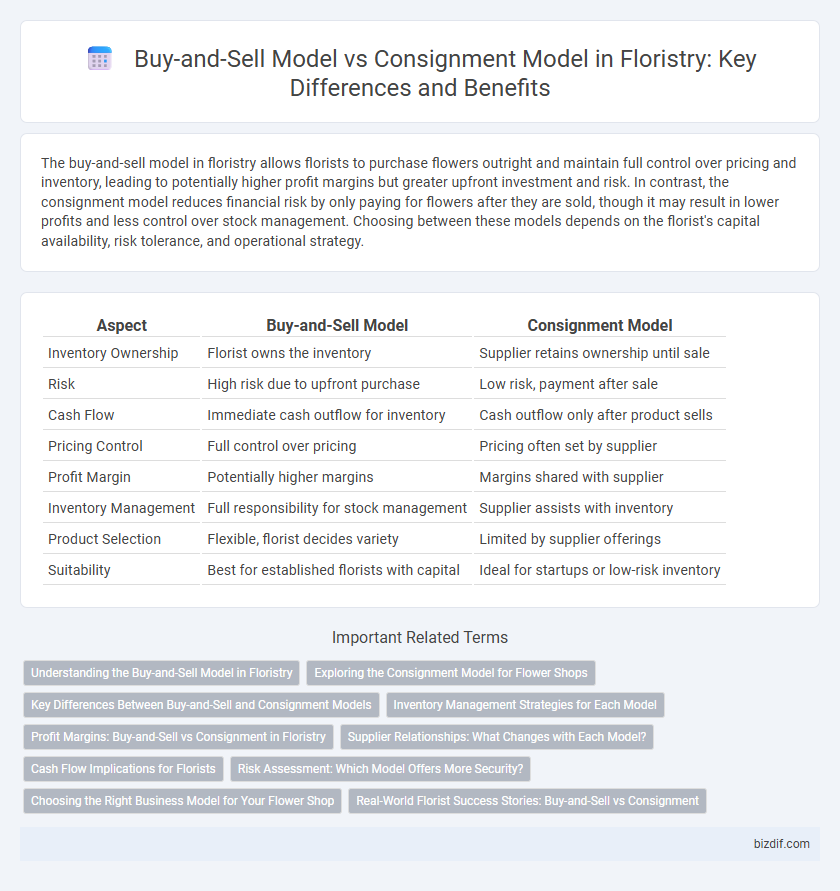The buy-and-sell model in floristry allows florists to purchase flowers outright and maintain full control over pricing and inventory, leading to potentially higher profit margins but greater upfront investment and risk. In contrast, the consignment model reduces financial risk by only paying for flowers after they are sold, though it may result in lower profits and less control over stock management. Choosing between these models depends on the florist's capital availability, risk tolerance, and operational strategy.
Table of Comparison
| Aspect | Buy-and-Sell Model | Consignment Model |
|---|---|---|
| Inventory Ownership | Florist owns the inventory | Supplier retains ownership until sale |
| Risk | High risk due to upfront purchase | Low risk, payment after sale |
| Cash Flow | Immediate cash outflow for inventory | Cash outflow only after product sells |
| Pricing Control | Full control over pricing | Pricing often set by supplier |
| Profit Margin | Potentially higher margins | Margins shared with supplier |
| Inventory Management | Full responsibility for stock management | Supplier assists with inventory |
| Product Selection | Flexible, florist decides variety | Limited by supplier offerings |
| Suitability | Best for established florists with capital | Ideal for startups or low-risk inventory |
Understanding the Buy-and-Sell Model in Floristry
In floristry, the buy-and-sell model involves florists purchasing flowers directly from growers or wholesalers and assuming full ownership before selling them to customers. This approach requires upfront investment and inventory management but allows florists greater control over pricing, product selection, and profit margins. Efficient demand forecasting and quality control are critical in maximizing profitability and reducing waste under this model.
Exploring the Consignment Model for Flower Shops
The consignment model allows flower shops to display and sell floral arrangements without upfront inventory costs, reducing financial risk and improving cash flow management. This approach offers flexibility in inventory control, enabling shops to update floral selections based on customer demand and seasonal trends. By partnering closely with growers and suppliers, flower shops can create a dynamic inventory system that enhances customer satisfaction through fresher, more diverse floral options.
Key Differences Between Buy-and-Sell and Consignment Models
The buy-and-sell model in floristry requires retailers to purchase inventory upfront, assuming all sales risk and benefiting from immediate ownership of flowers. In contrast, the consignment model enables retailers to display and sell flowers without initial payment, with suppliers retaining ownership and only receiving payment after successful sales. Key differences include inventory control, risk distribution, cash flow impact, and supplier-retailer dependency, affecting profitability and operational flexibility for florists.
Inventory Management Strategies for Each Model
The buy-and-sell model in floristry requires retailers to purchase floral inventory upfront, demanding precise demand forecasting and effective stock rotation to minimize waste and optimize freshness. In contrast, the consignment model allows florists to hold inventory without ownership until sales occur, reducing financial risk but requiring robust tracking systems to manage consigned stock and supplier relationships. Both models benefit from advanced inventory management software tailored to monitor flower shelf life, sales velocity, and reorder points to ensure continuous supply and profitability.
Profit Margins: Buy-and-Sell vs Consignment in Floristry
The buy-and-sell model in floristry typically offers higher upfront profit margins since retailers purchase flowers outright and control pricing strategies. In contrast, the consignment model often results in lower profit margins due to shared revenue with suppliers and unsold inventory risks being borne by the florist. Evaluating profit margins between these models depends on factors like inventory turnover rates, supplier agreements, and market demand for floral arrangements.
Supplier Relationships: What Changes with Each Model?
The buy-and-sell model requires suppliers to transfer full ownership of floral products to retailers, fostering straightforward transactions but shifting inventory risk to the seller. In contrast, the consignment model allows suppliers to retain ownership until products are sold, enhancing supplier involvement and collaboration but requiring transparent inventory tracking and shared risk management. Supplier relationships in consignment models tend to be more strategic and trust-based due to ongoing inventory oversight and joint sales accountability.
Cash Flow Implications for Florists
Buy-and-sell models require florists to invest upfront in inventory, impacting cash flow by tying capital to stock that may not sell immediately. Consignment models improve cash flow by allowing florists to display and sell flowers without initial purchase, paying suppliers only after successful sales. Managing cash flow effectively under each model influences a florist's ability to maintain fresh inventory and meet customer demand.
Risk Assessment: Which Model Offers More Security?
The consignment model offers more security in floristry by reducing upfront financial risk, as sellers only pay for flowers once sold, limiting inventory losses. In contrast, the buy-and-sell model requires florists to purchase inventory upfront, increasing exposure to unsold perishable goods and cash flow challenges. Risk assessment favors consignment for florists seeking minimized financial loss and improved inventory flexibility.
Choosing the Right Business Model for Your Flower Shop
The buy-and-sell model allows florists to maintain full control over inventory and pricing, leading to potentially higher profit margins but requiring upfront investment and risk of unsold stock. The consignment model minimizes financial risk by only paying suppliers once flowers are sold, promoting fresher stock turnover but reducing immediate profitability due to shared revenue. Selecting the optimal business model depends on cash flow capacity, inventory management skills, and market demand patterns specific to your flower shop's location.
Real-World Florist Success Stories: Buy-and-Sell vs Consignment
Successful florists using the buy-and-sell model report higher cash flow and inventory control, allowing faster adaptation to market trends and customer preferences. In contrast, consignment model users experience reduced upfront costs and less risk, as suppliers retain ownership until sale, promoting a wider selection with lower financial burden. Real-world examples show hybrid approaches can optimize profit margins and customer satisfaction by balancing inventory risk with variety and freshness.
Buy-and-sell model vs consignment model Infographic

 bizdif.com
bizdif.com